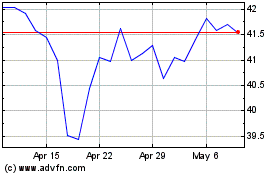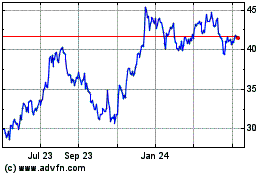A Sore Spot for Regional Lenders -- WSJ
October 20 2016 - 3:02AM
Dow Jones News
Slowing demand for commercial loans takes a toll on results at
smaller banks
By Rachel Louise Ensign and Austen Hufford
A trading rebound drove growth at big banks in the third
quarter. Traditional lenders, lacking that prop, were left to
continue battling superlow interest rates.
Firms such as U.S. Bancorp., which reported earnings Wednesday,
faced slowing demand for commercial loans, a flattening yield curve
and declining net-interest margins. Net profit rose just 1% versus
a year earlier.
Morgan Stanley, meanwhile, reported a 57% gain in net income,
thanks in part to outsized gains in its bond-trading business.
That is a turn in fortunes. Regional banks such as
Minneapolis-based U.S. Bancorp typically fetch higher valuations
than firms with more volatile trading operations. And, since the
start of this year, U.S. Bancorp has had a larger market value than
either Morgan Stanley or Goldman Sachs Group Inc.
That, though, is also due to the fact that U.S. Bancorp has
posted higher returns on equity than bigger banks. Its return was
13.5% in the third quarter. While down from 14.1% a year earlier,
it was still miles ahead of returns of 11.6% and 11.2% at Wells
Fargo & Co. and Goldman Sachs Group Inc., respectively. Those
two had the highest returns of the biggest U.S. banks in the
quarter.
Still, the regional banks' lack of diversity worked against them
in the third quarter, especially as a second rate increase from the
Federal Reserve failed to materialize. U.S. Bancorp's net-interest
margin, a measure of the difference between what it pays out on
deposits and receives on loans and investments, fell to 2.98% in
the third quarter from 3.02% the prior one. That is the lowest the
margin has ever been at the bank, said finance chief Terry
Dolan.
The bank said it expects the margin figure to fall further in
the fourth quarter due to the shape of the yield curve. In recent
months, long-term rates have declined without a corresponding drop
in short-term interest rates, a phenomenon known as a flattening of
the yield curve. That squeezes bank profits.
To compensate, banks need loan growth. But business lending,
which has been one of the strongest areas of loan growth in recent
years, fell slightly in the quarter across the banking industry.
That was the first time this has happened in six years.
U.S. Bank Chief Executive Richard Davis said that likely
reflected the U.K.'s Brexit vote and the coming U.S. election. He
expects growth to pick up again in the fourth quarter.
Similar concerns surfaced at BB&T Corp. and M&T Bank
Corp., which also reported results Wednesday. Both showed
commercial-loan growth rates that flagged from the prior
quarter.
"Loan growth in today's market, to be honest, is just very, very
challenging," said Chief Executive Kelly King. Average total loans
at BB&T grew 0.3% on an annualized basis from the prior quarter
and fell in a number of commercial-loan segments.
Still, the regional banks managed to grind out profits in the
face of these headwinds. Winston-Salem, N.C.-based BB&T
reported earnings of $642 million, up from $533 million a year
earlier. Its total revenue, which is a combination of net interest
income and fee-based income, grew 13% to $2.77 billion, above
analyst expectations.
At M&T Bank, overall loans rose 1% from the prior quarter
and commercial loans were essentially flat. Results came in ahead
of Wall Street expectations, though. M&T reported earnings of
$350 million, up from $280.4 million a year earlier.
Write to Rachel Louise Ensign at rachel.ensign@wsj.com and
Austen Hufford at austen.hufford@wsj.com
(END) Dow Jones Newswires
October 20, 2016 02:47 ET (06:47 GMT)
Copyright (c) 2016 Dow Jones & Company, Inc.
US Bancorp (NYSE:USB)
Historical Stock Chart
From Mar 2024 to Apr 2024

US Bancorp (NYSE:USB)
Historical Stock Chart
From Apr 2023 to Apr 2024
